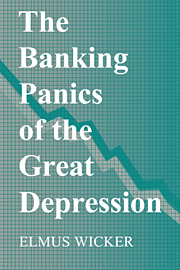1 - The banking situation in the United States, 1921—33
Published online by Cambridge University Press: 25 October 2009
Summary
The dimensions of the bank failure problem are clearly revealed in the data on bank suspensions. The total number of commercial banks in the US was reduced by one–half between 1921 and 1933. This drastic shrinkage in the number of independent banks represents the single most important development in the banking industry in the interwar period. A grand total of 15,348 banks were either suspended or merged with other banks. Of that number 14,808 suspended operations, 5,712 of which closed between 1921 and 1929 (39 percent) and 9,096 (61 percent) between 1930 and 1933. As we can see from table 1.1, bank failures were a recurring feature of the post–World War 1 financial landscape.
Banking failures between 1921 and 1929 were not panic related; this was a relatively panic–free period when bank suspensions had no effect on general depositor confidence as measured by an increase in currency in circulation. Between 1930 and 1932 of the more than 5,000 banks that closed only 38 percent suspended during the first three banking crisis episodes. Banking crisis episodes are identifiable in only ten of the thirty–six months: November 1930 to January 1931, April to August 1931, and September and October 1931. The percentage of banks failing in panic designated months was forty–five in 1930, fifty–seven in 1931 and zero in 1932. Over 60 percent of bank closings occurred in nonpanic months.
That is not to say that the ending of a banking crisis episode did not leave a residue of increased hoarding, eroded depositor confidence, and falling security prices that affected bank solvency in subsequent periods.
- Type
- Chapter
- Information
- The Banking Panics of the Great Depression , pp. 1 - 23Publisher: Cambridge University PressPrint publication year: 1996

